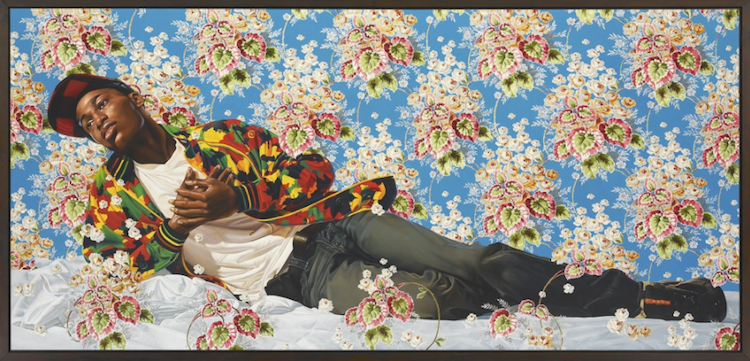Kehinde Wiley - written by Hope Ezcurra
There is a strong thematic element that has connected presidential portraits from George Washington's, our nation's first president, through to George W. Bush, our 43rd president 222 years later. The official portrait has been a tradition since 1796, generally an oil painting, nearly always standing in an office or official chamber, resolute looking, always a white man painted by a white man.
And then came Obama, the first US African American president, and convention was thrown gorgeously out the window. His portrait was painted by Kehinde Wiley, the first African American to paint a presidential portrait. But not only is it significant of who it was painted and by whom but also how it was painted. It is a riotous explosion of life. The official chamber was instead traded for a wall of lush green leaves, speckled with the occasional flowers from Chicago, Hawaii, and Kenya. Obama exists floating on a different plane than the foliage, but his plane intersects with the leaves near his feet. He sits on a chair that is vaguely regency style, borrowing design motifs from both the 18th century and turn off the 20th century. His pose conveys both power and tranquility. The color saturation of Obama's skin is so strong that it suggests the vision of a tetrachromat; it is a love song to his melanin almost as if his flesh was lit from within.
The only homage to traditional presidential portraits is Obama's expression, he too stares resolutely at the viewer, with the exception of Kennedy's downturned gaze painted after his assassination, Kehinde Wiley did not break with that convection.
Homage to convention, is a theme that runs through Kehinde Wiley's glorious celebration of modern black men and women. Not only does he honor by overturning the conventions of traditional portraiture by seating a dark skinned person at their center, but also pays his dues to the classic imagery of Hip-hop culture and material trappings of blackness in America. He paints his subjects naturalistically, almost always in grandiose classical possess against or in lush backgrounds of leaves or plants. They often emulate thematic elements of William Morris textiles, drawing parallels with old regency homes. Born in South Central Los Angeles in 1977, and now based out of New York; Wiley attended the Art Institute in SF and got his MFA at Yale. His paintings are both a love letter to his subject's blackness and the imagery of classical portraits. He is gifting his subjects the same regal power that was denied to their ancestors, notably absent from the portraiture he evokes. While it is done in a way respectful of the artistry he subverters, the visual tropes he utilizes speak both to power and elegance as well marginalization and discrimination, both historical and in our present day world. Speaking on his yellow wallpaper series he said that he focused on "correlations between the sense of powerlessness and the sense of invention that happens in a person who’s not seen, who’s not respected and whose sense of autonomy is in question,”. His artwork is a luxuriant commentary on race, power, the history of art, and representation.
Hansen, Michele. “About That Chair In President Obama's Portrait.” Medium, Medium, 21 Feb. 2018, medium.com/@mjwhansen/about-that-chair-in-president-obamas-portrait-56f07617efe4.
“Presidential Portraits.” The White House Historical Association, The White House Historical Association, www.whitehousehistory.org/galleries/presidential-portraits.
Wrathall, Claire. “Kehinde Wiley: 'I Took the DNA of William Morris and Created Hybrids'.” The Guardian, Guardian News and Media, 25 Jan. 2020, www.theguardian.com/artanddesign/2020/jan/25/kehinde-wiley-william-morris-exhibition-interview.






